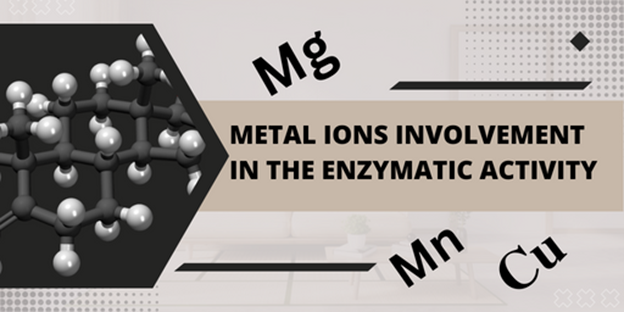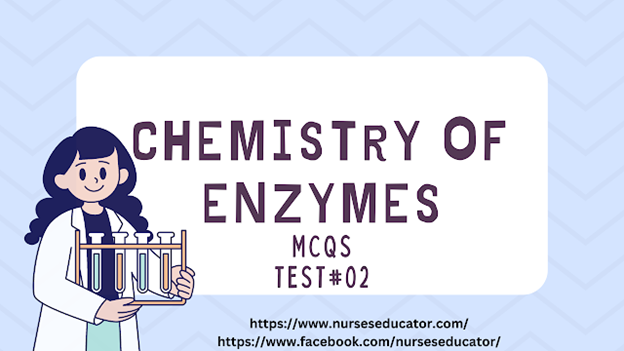Metal Ions Involvement in the Enzymatic Activity. Metal Ions and Enzymes activity, Enzyme Classification, Enzyme Action Model , Nomenclature of Enzyme, Classification and Enzyme Specificity.
Metals Play Variety of Roles Such As:
They help in either maintaining or producing (or both), active structural conformation of the enzyme,
- Formation of enzyme-substrate complex,
- Making structural changes in substrate molecule,
- Accept or donate electrons,
- Activating or functioning as nucleophiles, and
- Formation of ternary complexes with enzymes or substrate.
| Metal Ion | Enzymes |
| Copper | Superoxide Dismutase, Cytochrome Oxidase, |
| Calcium | Lipase, Lecithinase |
| Iron | Catalase, Xanthine Oxidase, Peroxidase Cytochrome Oxidase. |
| Manganese | Hexokinase, Enolase, Phosphoglucomutase, Glycosyl Transferase |
| Magnesium | Hexokinase, Enolase, Glucose-6- Phosphatase, Phosphofructokinase |
| Molybdenum | Xanthine Oxidase |
| Zinc | Carbonic Anhydrase, Alcohol Dehydrogenase, Carboxy Peptidase, Alkaline Phosphatase (ALP), Lactate Dehydrogenase (LDH). |
Nomenclature and Classification of Enzymes
Metal Ions Involvement in the Enzymatic Activity, Classification, Mechanism of Enzyme Action and Enzyme Action Model: Enzymes are generally named after adding the suffix ‘ ase ‘ to the name of the substrate, e.g. enzymes acting on nucleic acids are known as nucleases, enzymes hydrolyzing dipeptides are called dipeptidases. Even though a few exceptions such as trypsin, pepsin, and chymotrypsin are still in use.
Further, few enzymes exist in their inactive forms and are called proenzymes or zymogens, e.g. pepsin has pepsinogen as its zymogen. The zymogens become active after undergoing some prior modification in its structure by certain agents. Many times, the active form of enzyme acts on zymogen and catalyzes its conversion into active form and this process is called as autocatalysis.
In order to have a uniformity and unambiguity in identification of enzymes, International Union of Biochemistry (IUB) adopted a nomenclature system based on chemical reaction type and reaction mechanism. According to this system, enzymes are grouped into six main classes.
- Each enzyme is characterized by a code number (enzyme code No. or EC No) comprising four figures (digits) separated by points, the first being that of the main class (one of the six ).
- The second figure indicates the type of group involved in the reaction.
- Third figure denotes the reaction more precisely indicating substrate on which the group acts.
- The fourth figure is the serial number of the enzyme. Briefly, the four digits characterize class, sub-class, sub-sub-class and serial number of a particular enzyme.
Six classes are:
- Oxidoreductase: Enzymes involved in oxidation and reductions of their substrates, eg alcohol dehydrogenase, lactate dehydrogenase, xanthine oxidase, glutathione reductase,
glucose-6-phosphate dehydrogenase.
- Transferases: Enzymes that catalyze transfer of a particular group from one substrate to another, e.g. aspartate and alanine transaminase (AST/ALT), hexokinase, phosphoglucomutase, hexose-1-phosphate uridyltransferase, ornithine carbamoyl transferase, etc.
- Hydrolases: Enzymes that bring about hydrolysis, e. g.glucose -6-phosphatase, pepsin, trypsin, esterase, glycoside hydrolases, etc.
- Lyases: Enzymes that facilitate removal of small molecules from a large substrate, e.g. fumarase, arginosuccinase , histidine decarboxylase.
- Isomerases: Enzymes involved in isomerization of substrate, e.g. UDP-glucose, epimerase, retinal isomerase, racemases, triosephosphate isomerase.
- Ligases: Enzymes involved in joining together two substrates, e.g. alanyl-t. RNA synthetase, glutamine synthetase, DNA ligases.
Many times, the word ‘OTHLIL’ is used to remember the six classes.
Specificity Of Enzymes
Another important property of enzymes is their specificity. The specificity is of three different types namely:
- Stereochemical specificity,
- Reaction specificity, and
- Substrate specificity.
stereospecificity
1. Optical specificity
There can be many optical isomers of a substrate.
Metal Ions Involvement in the Enzymatic Activity, Classification, Mechanism of Enzyme Action and Enzyme Action Model: However, it is only one of the isomers which acts as a substrate for an enzyme action , eg for the oxidation of D- and L-amino acids, there are two types of enzyme which will act on D- and L-isomers of amino acids. Secondly there can be a product of enzyme action which can have isomers. However, it is only one kind of isomer which will be produced as a product, eg succinic dehydrogenase while acting on succinic acid will give only fumaric acid and not malic acid which is its isomer.
2. Reaction Specificity
A substrate can undergo many reactions but in a reaction specificity one enzyme can catalyse only one of the various reactions . For example, oxaloacetic acid can undergo several reactions but each reaction is catalyzed by its own separate enzyme which catalyses only that reaction and none of the others.
3. Substrate Specificity
The extent of substrate specificity varies from enzyme to enzyme. There are two types of substrate specificity viz, absolute specificity and relative specificity
- Absolute specificity is comparatively rare such as urease which catalyzes hydrolysis of urea.
- Relative substrate specificity is further divided as:
- Group dependent or
- Bond dependent.
Examples of group specificity are trypsin, chymotrypsin. Trypsin hydrolyses the residues of only lysine and arginine, while chymotrypsin hydrolyses residues of only aromatic amino acids.
4. Bond Specificity
Bond specificity is observed in case of proteolytic enzymes, glycosidases and lipases which act on peptide bonds, glycosidic bonds and ester bonds respectively.
Mechanism of Enzyme Action
Michaelis and Menten have proposed a hypothesis for enzyme action, which is most acceptable. According to their hypothesis, the enzyme molecule (E) first combines with a substrate molecule (S) to form an enzyme substrate (ES) complex which further dissociates to form product (P) and enzyme (E) back. Enzyme once dissociated from the complex is free to combine with another molecule of substrate and form product in a similar way.
The ES complex is an intermediate or transient complex and the bonds involved are weak non-covalent bonds, such as H-bonds, Van der Waals forces, hydrophobic interactions. Sometimes two substrates can bind to an enzyme molecule and such reactions are called as bisubstrate reactions . The site to which a substrate can bind to the enzyme molecule is extremely specific and is called as active site or catalytic site .
Normally the molecular size and shape of the substrate molecule is extremely small compared to that of an enzyme molecule. The active site is made up of several amino acid residues that come together as a result of folding of secondary and tertiary structures of the enzyme. So, the active site possesses a complex three-dimensional form and shape, provides a predominantly non-polar cleft or crevice to accept and bind the substrate. Few groups of active site amino acids are bound to substrate while few groups bring about change in the substrate molecule.
Models of enzyme-substrate complex formation
These interactions have been described basically of two types.
- Template or Lock-and-Key Model
This model was originally proposed by Fischer which states that the active site already exists in proper conformation even in absence of substrate. Thus, the active site by itself provides a rigid, pre-shaped template fitting with the size and shape of the substrate molecule.
Substrate fits into active site of an enzyme as the key fits into the lock and hence it is called the lock-and-key model. This model proposes that substrate binds with rigid pre-existing template of the active site, provides additional groups for binding other ligands. But this cannot explain change in enzymatic activity in presence of allosteric modulators
- Induced Fit or Koshland Model
Because of the restrictive nature of lock-and-key model, another model was proposed by Koshland in 1963 which is known as induced-fit model. The important feature of this model is the flexibility of the region of active site. According to this, active site does not possess a rigid, preformed structure on enzyme to fit the substrate. On the contrary, the substrate during its binding induces conformational changes in the active site to attain the final catalytic shape and form . This explains several matters related to enzyme action such as:
- Enzymes become inactive on denaturation,
- saturation kinetics,
- Competitive inhibition, and
- Allosteric modulation.
https://youtu.be/1QF809BqV2E
Reference: Notes Made By The Help of“The Text Book of Medical Biochemistry By MN. Chatterjea 8th Edition”
Read More:
https://nurseseducator.com/didactic-and-dialectic-teaching-rationale-for-team-based-learning/
https://nurseseducator.com/enzymes-co-enzymes-and-mcqs/
https://nurseseducator.com/high-fidelity-simulation-use-in-nursing-education/
First NCLEX Exam Center In Pakistan From Lahore (Mall of Lahore) to the Global Nursing
Categories of Journals: W, X, Y and Z Category Journal In Nursing Education
AI in Healthcare Content Creation: A Double-Edged Sword and Scary
Social Links:
https://www.facebook.com/nurseseducator/
https://www.instagram.com/nurseseducator/

